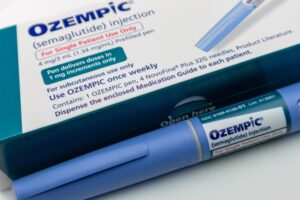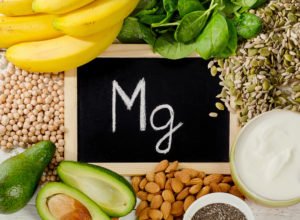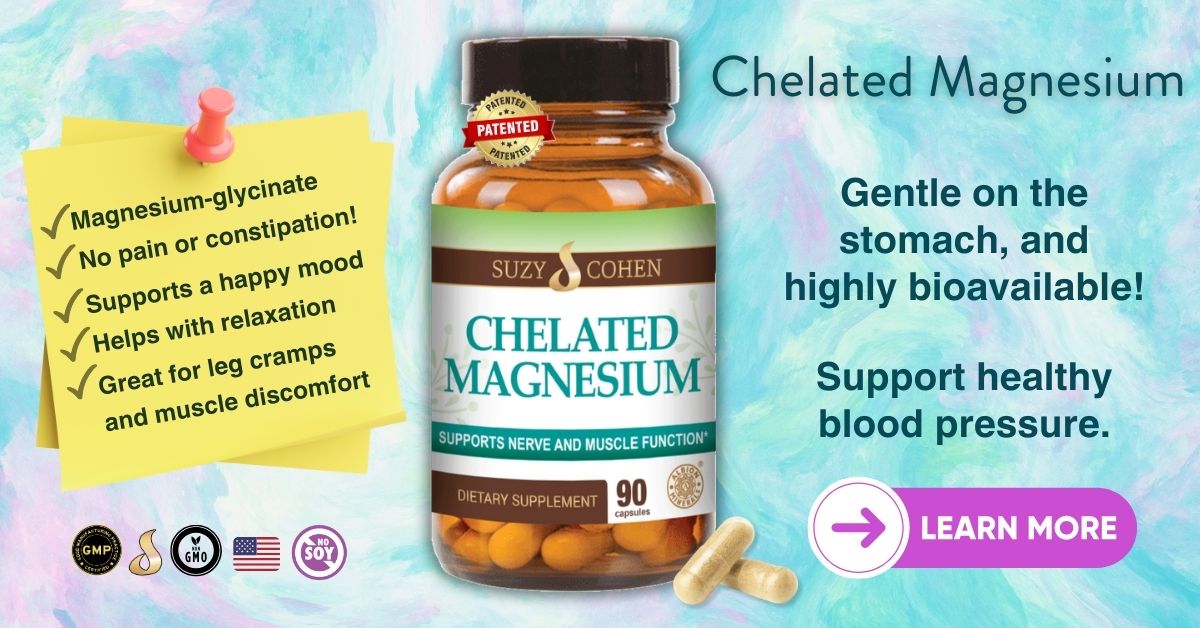What's On This Page?
ToggleIf you’re injecting Ozempic (semaglutide) to manage your type 2 diabetes, you’re probably noticing some positive changes in your blood sugar levels and weight.
However, what you might not know is that Ozempic probably acts like a “drug mugger,” depleting essential nutrients your body needs to function at its best. I think this could be most noticeable to the elderly, or those people who have poor baseline nutrition… which is pretty common in those who have obesity. I’ll get into this more comprehensively in a minute, but just to make a point, magnesium could be depleted, and if you become very deficient in this mineral, it can impact your heart rhythm! Low mag can also lead to depression! Leg cramps and more. Knowing if a drug depletes a vitamin or mineral is critical to you feeling well.
The concept of “drug muggers” is a theory I’ve developed to explain how certain medications can deplete essential nutrients from your body, leading to various health issues. It’s not just medications either, it could be a medical condition such as celiac, and it could be a beverage like coffee (which depletes magnesium).
Just like a mugger takes something valuable from you, certain drugs can rob you of vitamins, minerals, and other nutrients that are vital for chemical reactions that keep you strong and healthy. This can happen with common medications for cholesterol, blood pressure, acid reflux, and even diabetes medications like Ozempic which belongs to a category of drugs called GLP-1 agonists.
Before we move on, I’ve written on this topic before. You might be interested in my other article on Ozempic, From Medication To Mother Nature: Exploring Ozempic And 11 Natural Alternatives For Weight Loss And Blood Sugar Balance.
How do GLP-1 Agonists Work? And Are They Derived from Reptiles?
I’ll get to the reptile part in a minute, hang on. As for their mechanism of action, Ozempic works in four different ways which are listed below. Here’s how:
Your body makes natural GLP-1 hormone whenever you eat. This is a hormone that sends signals out to manage how much sugar (glucose) is in your blood. So when you eat, your body secretes GLP-1 hormone and the drugs attach themselves to the receptors found in the cells of different organs like your pancreas, stomach and brain.
The drugs which are injected subcutaneously, go into the bloodstream and bind to the receptors which does several things:
- Help release insulin: Insulin is another hormone you make that helps move sugar out of your bloodstream and into your cells so the glucose can then be used for energy. More insulin means less sugar stays in your blood. Blood sugar levels go down to some extent (what you want).
- Lower glucagon levels: Glucagon is another hormone, but it raises blood sugar levels. By lowering glucagon, Ozempic and these other drugs help keep blood sugar from spiking (again, this is what you want).
- Slow down digestion: GLP-1 agonists slow down how fast the food you ate leaves your stomach. It improves satiety. It makes you feel full longer and can help reduce how much you eat. Eating smaller portions translates to losing weight.
- Make you feel full: They also send signals to your brain, influencing ghrelin levels, to make you feel full, which can help with weight loss. If you have my diabetes book you know all this, so I’ll just summarize it:
More ghrelin means more hunger. Less grehlin means you feel full.
More leptin means you feel full. Less leptin and you want to keep eating.
In short, GLP-1 receptor agonists help control blood sugar and appetite by acting like the natural hormone GLP-1. They are sometimes prescribed to people who have poor baseline nutrition which is where I worry most about the drug mugging effect.
The drugs don’t have direct actions upon leptin or ghrelin, however indirect effects impact digestion which can impact levels of both of those hormones. In short, the medications are used to help people with diabetes manage their condition better, and pretty much as a side effect, they lose weight!
Can a person do this with natural supplements that help balance blood sugar, and impact GLP-1 receptors? Absolutely! You don’t necessarily require a prescribed medication for this cascade of hormonal changes to occur. It happens naturally in people who don’t have diabetes, and have a healthy BMI.
Are you wondering if it’s made from lizards? There a rumor going around that I want to clarify for you since I am a pharmacist and in the know. It has to do with an active ingredient called exendin-4.
Clarifying the Origins: Ozempic vs. Byetta
There’s been some confusion floating around regarding the ingredients in Ozempic (semaglutide), especially concerning a peptide called exendin-4. Allow me to set the record straight and focus on the facts, not sensationalism.
Ozempic is a synthetic GLP-1 receptor agonist that mimics the effects of the natural GLP-1 hormone in our bodies. It’s designed using recombinant DNA technology, making it a close cousin to our natural GLP-1 but engineered for stability and longer action. This means Ozempic is administered once weekly, offering convenience for those managing type 2 diabetes or looking for help with weight loss.
Importantly, Ozempic does not contain “exendin-4,” nor is it derived from any exotic sources. It’s a lab-crafted peptide.
Now, let’s go over where the exendin-4 confusion comes in. Exenatide, the active ingredient in Byetta® and Bydureon® does contain exendin-4, but rather a synthetic version of exendin-4. In other words, there is no gila monster saliva in the drug! The researchers didn’t clean up the exendin-4 to make the exenatide, they started completely from scratch.

It’s true that the peptide originally studied came from Gila monster, but again, the finished drug on the market does not contain it, nor does it contain a modified version of it.
The same deal is with captopril, the popular drug for blood pressure. Snake venom was studied in order to make this anti-hypertensive, but the drug itself doesn’t have snake venom in it. Nature is full of wonders, isn’t it?
Anyway, exendin-4 is similar enough to human GLP-1 that it can effectively activate GLP-1 receptors, helping regulate blood sugar levels. Its natural resistance to degradation makes it useful for diabetic patience.
Understanding these differences is important to help you make informed decisions about your health. So, the next time you hear about Gila monsters and diabetes meds, remember: that’s Byetta’s claim to fame, not Ozempic’s.
Ozempic and Clan – These Drugs All Work Similarly
You may be wondering if Ozempic is the only GLP-1 inhibitor. No it’s not. Below I have listed several other drugs that work in the same way. Ozempic is a brand name for the drug semaglutide, which as you just learned belongs to a class of medications known as GLP-1 receptor agonists (glucagon-like peptide-1 receptor agonists). These medications are FDA approved for the management of type 2 diabetes and, in some cases, for weight loss. Other drugs in the same class as Ozempic include:
- Liraglutide (brand names: Victoza, Saxenda)
- Exenatide (brand names: Byetta, Bydureon)
- Dulaglutide (brand name: Trulicity)
- Lixisenatide (brand name: Adlyxin)
- Semaglutide (brand name: Wegovy)
- Tirzepatide (brand name: Mounjaro)*
*Mounjaro has dual actions → It is a GLP-1 receptor agonist and GIP (glucose-dependent insulinotropic polypeptide)

The drugs above work by mimicking the action of the GLP-1 hormone, which increases insulin secretion, decreases glucagon secretion, and slows gastric emptying, among other effects, helping to regulate blood sugar levels and potentially aiding in weight loss.
Given that these drugs share the same mechanism of action (MOA) as Ozempic, it is likely that they have similar effects on nutrient depletion.
Although each of these drugs may not have been studied independently regarding their impact on nutrient levels, largely due to the significant time and financial investment required for such studies, it can be reasonably inferred that their shared MOA would result in the depletion of the same nutrients as observed with Ozempic.
Let’s go with it to be on the safe side. If you take any of the drugs above consider nutrient restoration while you’re on the medication, so you can offset the drug-mugging effect.
Why Restoration is Important
Simply put, it keeps you safer. There are just 5 nutrients that I think you should replenish if you’ve been on Ozempic, or any similar drug for more than 2 months, or if you think you have poor baseline nutrition.
Restoring lost nutrients reduces your risk for nutrient depletions, keeping your enzymatic functions in order. If you take the lost vitamins/minerals while on your medication therapy, it’s keeping you healthier at least in my humble opinion.
Understanding which nutrients might be being depleted and knowing how to replenish them can help you avoid side effects and maintain optimal health. I wrote a book on this very topic.
For a deeper dive into how different medications can rob your body of nutrients and practical tips to restore them, you can check out my best-selling book, “Drug Muggers: Which Medications Are Robbing Your Body of Essential Nutrients—and Natural Ways to Restore Them.”
This book provides a comprehensive guide to understanding drug-nutrient interactions and how to take control of your health with the right supplements and dietary choices.
The 5 Must-Have Nutrients for Ozempic Users
1. Vitamin B12
Why You Need It: Vitamin B12 is crucial for keeping your nerves healthy, making DNA, and producing red blood cells. A deficiency can lead to fatigue, weakness, numbness or tingling in the hands and feet, and even memory problems.
Symptoms of Deficiency: If you’re low on B12, you might feel unusually tired, experience brain fog, have pale skin, or notice a smooth, red tongue. Some people may also experience mood changes, such as depression.
Relation to Ozempic: While direct evidence is sparse, the reduced food intake and potential changes in gastrointestinal function could theoretically reduce B12 and folate absorption, especially in individuals already at risk (ie those with pre-existing absorption issues like Leaky gut, celiac, crohn’s, IBS, chronic diarrhea, etc).

Foods to Eat: To boost your B12 levels, load up on animal-based foods like beef liver, clams, and fish such as salmon and trout. Dairy products like milk, yogurt, and cheese, as well as eggs, are also good sources.
Supplementation: If you want to supplement, look for methylcobalamin since it’s methylated, and will be better absorbed than other types. Some people like to take a B complex (which includes B12 and all the other related Bs) in order to keep them altogether for more pronounced benefits.
If you’re not already attached to a brand, I have a great one HERE which is the only fully methylated mitochondrial-loving B complex on the market.

2. Magnesium
Why You Need It: Magnesium is involved in over 300 biochemical reactions in your body, including those that regulate blood sugar levels, support muscle and nerve function, and keep your heart rhythm steady. A deficiency might cause muscle cramps, anxiety, migraines, and irregular heartbeats.
Symptoms of Deficiency: Signs you might be low in magnesium include muscle twitching, cramping, restless leg syndrome, insomnia, or even headaches and migraines.
Relation to Ozempic: If Ozempic contributes to reduced dietary intake and altered absorption, magnesium levels might decrease, potentially leading to these symptoms over time.
Foods to Eat: To up your magnesium intake, include more leafy greens like spinach and Swiss chard, nuts and seeds (especially pumpkin seeds and almonds), whole grains like brown rice, and fatty fish such as mackerel and salmon in your diet.
Supplementation: A good form is chelated magnesium because it’s easier on the stomach. I’d avoid magnesium oxide. Unless you have cognitive concerns, you wouldn’t necessarily need magnesium L-threonate. Click on the image below for more information. Also, here’s an article entitled, Your Brain Loves Magnesium L-Threonate And Here Are 5 Reasons To Use It.
3. Vitamin D
Why You Need It: Vitamin D helps your body absorb calcium, which is vital for bone health. It also plays a role in immune function and reducing inflammation. A deficiency can lead to bone pain, muscle weakness, and an increased risk of infections.
Symptoms of Deficiency: If you’re not getting enough vitamin D, you might experience frequent colds, feel fatigued or have bone pain, especially in your lower back or legs.

Relation to Ozempic: Vitamin D deficiency is widespread and typically related to lack of sunlight exposure and dietary intake rather than directly linked to medications like Ozempic. However, reduced intake of vitamin D-rich foods due to appetite suppression could play a role in exacerbating deficiency.
Foods to Eat: Vitamin D is known as the “sunshine vitamin” because your body can make it when your skin is exposed to sunlight. But you can also get it from foods like fatty fish (salmon, mackerel, sardines), fortified foods (like milk and orange juice), and egg yolks.
Supplementation: You can lay out in the sun if you want to, but sometimes this isn’t enough, and sometimes it isn’t an option (I’m thinking of living in geographic locations where it snows, or it’s cold for a good part of the year).
Still, there are those who cannot sulfate, and therefore activate their vitamin D precursors. Vitamin D undergoes two critical transformations to become active in the body: first in the liver, where it’s converted to 25-hydroxyvitamin D (calcidiol), and then in the kidneys, where it’s converted to the active form, 1,25-dihydroxyvitamin D (calcitriol).
For some people, impairments in sulfation pathways—a process that helps activate certain molecules, including hormone precursors—can interfere with vitamin D metabolism. This can lead to issues with fully converting and utilizing vitamin D effectively, which may contribute to vitamin D deficiency even if they get enough from sunlight or supplements.
Those with compromised sulfation capacity might need specific medical support to manage their vitamin D levels and overall health.
I am an advocate of vitamin D supplementation in small doses. Don’t overdo (and test yourself periodically) because excessive D raises calcium levels!
4. Folate (Vitamin B9)
Why You Need It: Folate is essential for making DNA and other genetic material. It’s also crucial for cell division. A deficiency can cause anemia, making you feel tired and weak, and can also affect mood and cognitive function.
Symptoms of Deficiency: Symptoms of low folate levels include fatigue, mouth sores, a swollen tongue, and difficulty concentrating. Pregnant women need to be especially mindful, as folate is crucial for fetal development.
Relation to Ozempic: GLP-1 agonists may indirectly increase the risk of folate deficiency due to its effects on appetite suppression, reduced food intake, and altered GI function, which suppresses folate absorption. While there is no direct evidence linking Ozempic to folate deficiency, people on this medication might be safer and endure fewer side effects if they supplement with folate if they have methylation SNPs, or have pre-existing risk factors for folate deficiency (ie celiac, IBS). You can easily monitor serum folate levels if you or your doctor want to.
Foods to Eat: Get more folate by eating dark green leafy vegetables like spinach and kale, legumes such as beans and lentils, avocados, and citrus fruits like oranges. Fortified cereals are also a great source.
Supplementation: Since vitamin B12 is also recommended, along with folate, my vote is that you just take a B complex supplement which contains both of those. It’s more affordable and better for you. But if you insist on just taking folate, make sure it is natural 5-MTHF not cheap “folic acid” which can possibly reduce your natural folate stash. More on this with a better explanation in my other article, How 15 Popular Medications Wipe Out Folate And Lead To Depression.
5. Potassium
Why You Need It: Potassium is key for maintaining normal fluid balance, nerve function, and muscle contractions. A deficiency might result in muscle weakness, cramping, fatigue, and even heart palpitations.
Symptoms of Deficiency: Look out for symptoms like muscle cramps, weakness, constipation, and irregular heartbeats. Low potassium can also make you feel tired and cause numbness or tingling sensations.
Relation to Ozempic: Potassium levels are sensitive to changes in dietary intake and gastrointestinal function. Although no direct link to Ozempic has been established, any drug that affects gut motility (or reduces food intake) will indirectly influence potassium levels to some extent.
Foods to Eat: To ensure you’re getting enough potassium, include bananas, sweet potatoes, spinach, avocados, and beans in your diet. Other good sources are tomatoes, oranges, and dairy products like yogurt.
Supplementation: You can eat a banana a day for this (bananas contain DOPAMINE) or drink an 8oz glass of unflavored Pedialyte® preferably the clear, un-dyed kind. I don’t like artificial colors, you can find out why HERE in my article on food dyes.

Summary
By being aware of these potential nutrient depletions and making sure you’re getting enough of these vital vitamins and minerals through diet or supplements, you can help counteract the “drug mugging” effects of Ozempic or similar drugs. Remember, always check with your healthcare practitioner before starting any new supplement regimen, even if they’re sold without prescription.
Forward this article to a friend if you think it could help.

Suzy Cohen, has been a licensed pharmacist for over 30 years and believes the best approach to chronic illness is a combination of natural medicine and conventional. She founded her own dietary supplement company specializing in custom-formulas, some of which have patents. With a special focus on functional medicine, thyroid health and drug nutrient depletion, Suzy is the author of several related books including Thyroid Healthy, Drug Muggers, Diabetes Without Drugs, and a nationally syndicated column.






